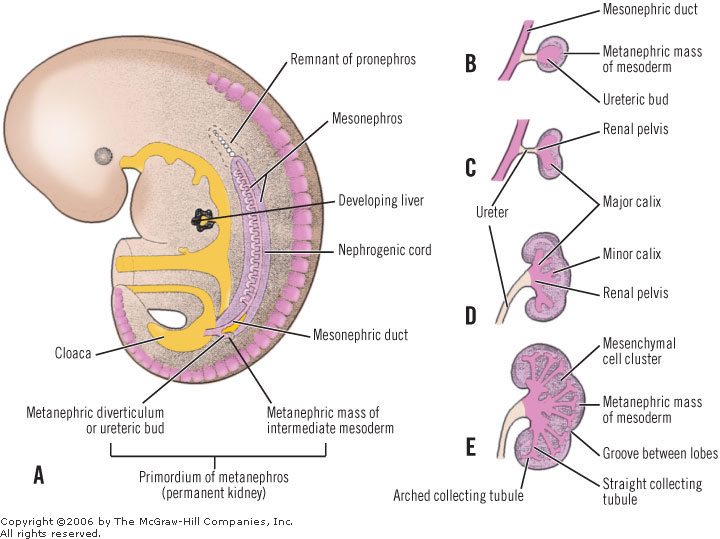Did you know that as humans we develop three kidneys? Well, you might be saying that cannot be for real because humans only have 2 kidneys. Well, don’t panic this article will take you through the development of the kidneys.
The 3 Stages of Development of the Kidney
There are 3 stages in the development of the kidney:
- Pronephros (A)
- Mesonephros(B)
- Metanephros(C)

PRONEPHROS
- This is the first kidney
- It develops during the 4th week of uterine life in the cervical region of the intermediate mesoderm.
- The pronephros contains lots of segmental vesicles and has the pronephric duct that grows caudally toward the cloaca.
- The pronephric duct is in the embryo and thus cannot filter materials outside the embryo. Therefore it is said that the pronephro kidney is nonfunctional in humans thus it degenerates.
THE MESONEPHROS (The 2nd Kidney)
- The Mesonephros kidney follows the development pronephros in about the ending of 4th week of uterine life. It is also comes from intermediate mesoderm and is located in the throcolumbar area where the pronephric duct that was developed in the pronephos stage continue to elongated caudally and become the mesonephric tubules. Most of this tububles eventually degenerates but leave behind the Mesonephric duct or Wolffian duct which extends towards the cloaca
- The mesonephros is the functioning kidney during the 1st trimester and it produces urine during weeks 6-10.
- It contributes to the:
- Epipdymis
- Vas deferens
- Seminiferous tubules
THE METANEPHROS (The Permanent Kidney)
- This kidney begins to develop in the 5th week of the embryonic period.
- It appears in the sacral region of the intermediate mesoderm
- During the 5th week the Mesonephric duct fomr the mesonephros kidney develops an outgrowth called the ureteric duct. This duct is close to the attachment of the cloaca.
- The ureteric duct eventually form the:
- ureter
- renal pelvis
- major calyces
- minor calyces
- collecting tubules
- The ureteric bud interacts with a portion of undifferentiated intermediate mesoderm called the metanephric mesenchyme. This interaction induces differentiation and thus the formation of the:
- renal tubules
- glomerulus
- distal and proximal convoluted tubules
- Loops of Henle
If there is an abnormal interaction between the ureteric bud and the metanephric mesenchyme, several congenital malformations of the kidney may result.


Hey Leslie,
Your videos are awesome! I’m watching these to help me study for my MCAT.
Have you done videos over the renal system yet? Those would be the most helpful!
Keep doing an awesome job!
-Mary Dang
Just wanted to say thank you. These are quick, informative reads 🙂 and so much easier to understand vs. psuedohypoparathyroidism and how the role of the kidney differs in say, osteitis fibrosa cystica or some other esoteric term for something that could be coveyed much clearer. lol….gotta love med school. questions 🙂 Good luck to you, Sonya!